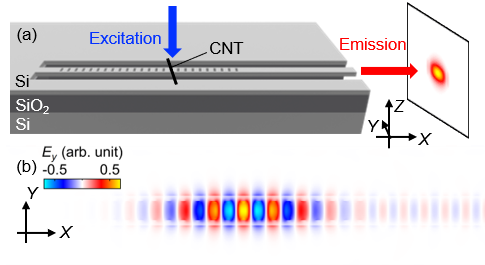Research:Waveguide coupled cavity-enhanced light emission from individual carbon nanotubes
Silicon photonics has enabled on-chip integration of various optical components, expanding the capabilities of monolithic photonic circuits. Single-walled carbon nanotubes (CNTs) are promising candidates as nanoscale light emitters in silicon photonics because they exhibit photoluminescence in telecom-wavelength regime at room temperature and can be grown directly on silicon substrates. By utilizing silicon optical microcavities, it has been possible to enhance the emission from CNTs and to narrow the emission spectrum, which is important in optical communications. The next step toward on-chip devices is to couple the light enhanced by the cavity to an optical waveguide, connecting the light emitter and other optical components for mutual access. In addition, in order to harness the unique optical properties of CNTs such as single photon emission, it is important to isolate individual CNTs and keep cleanliness of CNTs and devices.
In this work, individual CNT telecom-wavelength emitters are integrated onto a microcavity and a waveguide. Using finite-difference time-domain (FDTD) simulations, we have modified an air-mode PC nanobeam cavity to have one thin end mirror for guiding the light into the waveguide. CNTs are grown on a SiO2/Si substrate and transferred on the cavities through an all-dry process ensuring cleanliness of CNTs and devices.

We investigate photoluminescence characteristics of the devices using two geometries: a top detection configuration that measures light emission from CNTs on a nanobeam cavity, and a side detection configuration that collects light emission coupled to the waveguide. Figure(a) shows a PL spectrum of a CNT coupled to a cavity measured by the top detection configuration. Since the cavity linewidth is considerably narrower than the CNT linewidth at room temperature, devices showing a sharp peak component indicate that CNT emission is coupled to the cavity. For the device coupled with a single CNT, we investigate the PL emitted from the nanobeam waveguide facet. Figure(b) shows a waveguided CNT PL spectrum of the same device shown in Fig.(a). The light emission from the identified CNT is enhanced at the cavity resonance and extracted from the waveguide facet. Compared to the spectrum in Fig.(a), the broad CNT component is suppressed due to the PC bandgap. The waveguide-coupled light can easily be connected to various optical components on a monolithic chip and optical fibers.

To learn more about this work, please refer to:
Waveguide coupled cavity-enhanced light emission from individual carbon nanotubes
APL Photonics
6, 031302 (2021).
![]()